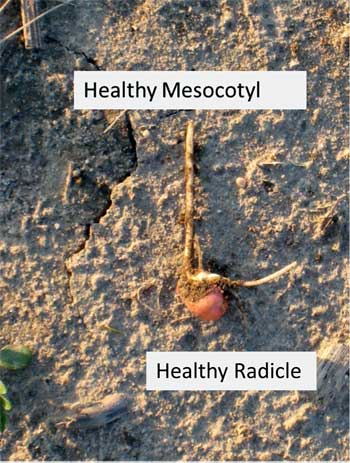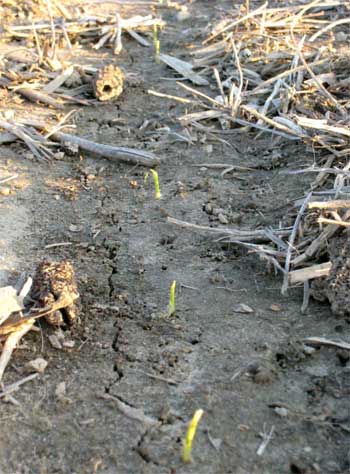Environmental conditions surrounding planting impact corn stand and viability
Cool, wet spring weather impacts seed germination and hardiness. Farmers can assess stands to see how April-planted corn endured.
Corn germinates well when soil temperature is 68 degrees. However, since April 1, mid-Michigan soil temperature averaged only 50 degrees with a high of 65.6 and low of 39.8 degrees (according to the Ithaca Enviro-weather station). Cool, wet soils lead to slow germination and emergence, leaving the seedling vulnerable to disease and insect damage.
With 45 percent of the corn planted in Michigan (National Agricultural Statistics Service, May 6), farmers in areas where the weather has remained cool and wet for the last week should check their fields to determine the progress of corn germination and emergence.
Here are some tips when scouting fields. Determine the number of emerged plants and check underground to see the fate of the seed:
- The Mesocotyl should be white and firm. This is the pipeline for nutrients from the seed to the growing seedling until the V6 stage.
- The seed should be free of insect damage.
- Germinated seed should be free of disease.
Leaves should not unfurl until above ground. Factors that may cause this are cold temperature injury, exposure to light, injury from certain herbicides or surface crusting.


Corn planted April 24, emerged May 9.
Consistent emergence, where there was a skip, the seed was examined to
determine health.
As soils warm and growing conditions improve, corn progress will also improve. The early vegetative stage – when corn rows are easily identified – is a good time to evaluate the stand to determine if a replant is necessary. Robert Nielsen at Purdue University has a comprehensive worksheet that will walk you through the decision process. Estimating Yield and Dollar Returns from Corn Replanting is a very thorough worksheet, but worth the effort as many factors go into the final decision.
Spring in Michigan brings new challenges each year. Assessing the viability of your corn stand at an early stage will provide insight into management practices that could be put in place in the future to impact the outcome.
Resources
- The Emergence Process in Corn, Robert Nielsen, Purdue University
- Check General Root and Mesocotyl Health when Assessing Corn Stands, Alison Robertson and Gary Munkvold, Iowa State University
- Estimating Yield and Dollar Returns from Corn Replanting, Robert Nielson, Purdue University



 Print
Print Email
Email



